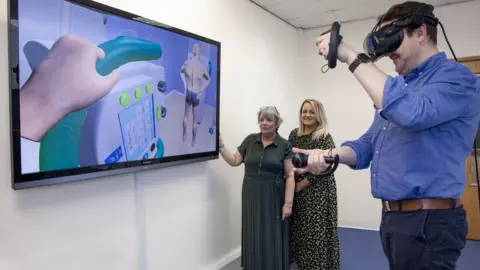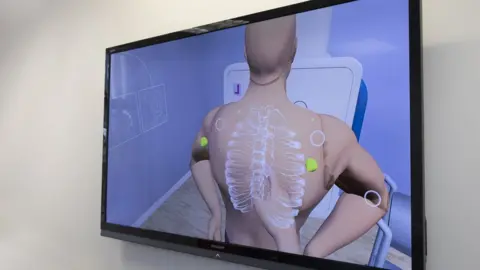Bangor Uni uses virtual reality to train radiographers
 BBC
BBCVirtual reality is being used to help aspiring radiographers learn how to use X-ray machines.
Bangor University is using gaming-style 3D graphics along with virtual patients to help students learn quickly and reduce the shortage of operators.
In addition, they will not be exposed to radiation that comes with regularly doing the procedure.
The system recreates an X-ray suite, which usually costs about £250,000, at a fraction of the cost.
The £15,000 virtual reality (VR) software system was developed in New Zealand and Bangor University is one of the first universities in the world to use it to train students, alongside the likes of Harvard University in the United States.
Speaking at the university's campus in Wrexham, third year students Connie McMahon and Zoe Gonzales were among the first to try the kit out.

Ms McMahon said: "It's a bit strange at first because you have to get used to the controls and your perception of where you are, but it's quite funny how quickly your brain adapts to where you are. It allows you to focus on your technique."
Ms Gonzales added: "Before, we couldn't take X-rays because of the radiation, but with this technology we're able to see the images and experience pressing the buttons and exposing. You're able to do the experience from the beginning until the end."
The innovative use of VR means limits on practical learning due to exposure to ionising radiation "no longer apply", according to Delyth Hughes, course leader for diagnostic radiography at Bangor University.
"One of the most important things students have to learn is how to position so that the X-ray will be taken at the right angle to show any possible issues with the patient," she explained.
"Using VR, the student can position a virtual patient and then see if they've got it right without any of those issues of expense and exposure."

Bangor University has increased its annual intake of student radiographers by 25% to 35 to help meet a shortage in the NHS.
Jonathan Grant, lecturer in diagnostic radiography at the university, said this training could help "replenish" the number of qualified radiographers in the UK.
He added: "We have a number of students in the university hoping to do that, and if we can make them competent clinical practitioners at the end of their three years through using our X-ray suite and the VR, they're going to improve patient experience and the number of radiographers throughout the NHS."

- CAN MUSHROOMS SAVE THE WORLD?: What makes mushrooms so magical?
- THE LONG WALK HOME: 20,000 miles, 4 years, 1 man

